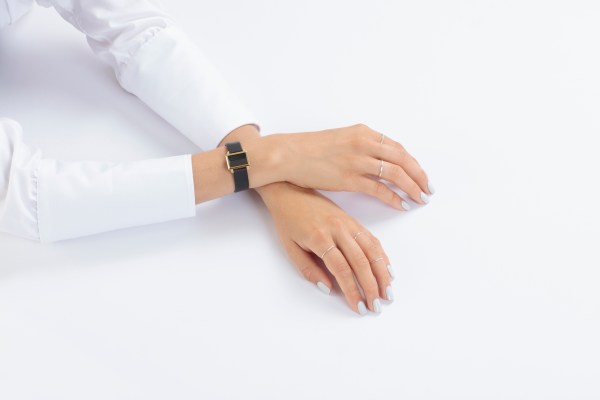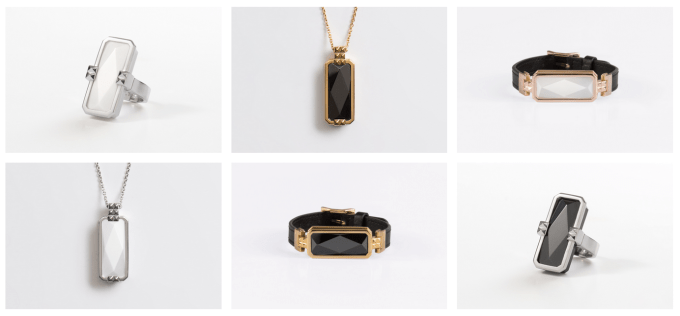2016 had a little more woe to deliver in the wearables space as London-based high end connected device maker, Vinaya, went into administration last month.
In a letter sent to Indiegogo backers of one of its wearables — and seen by TechCrunch — the founders also confirm the crowdfunded device will not ship. The Zenta wrist-wearable had been slated to ship this April, after the startup pulled in more than $270,000 in July from 1,300+ backers. Early bird pre-order prices for the device started at $149.
Nor will backers receive a refund, although the letter suggests they might see some form of alternative compensation/reward in future — such as a new future product or equity in the restructured company — if it is able to get back on its feet successfully. (You can read the email sent to backers in full at the bottom of this post.)
Any backers with queries are asked to email support@vinaya.com. The company claims its existing wearables will continue to work “for the foreseeable future”.
Late last week founder and CEO Kate Unsworth told BI the startup would be “restructuring” and spinning out certain parts of the business. We’ve contacted Unsworth and lead investor in the business, Passion Capital’s Eileen Burbidge, with questions and will update this story with any response.
In a press statement about closing the company, the startup writes that a decision was made to do so last month, after which bids were invited for the assets — with the founders submitting their own bid which they say was “ultimately successful”. There’s no detail on how many bids were received, nor the value of the winning bid.
One of the options they say they are now considering is a pivot out of the b2c consumer tech space to focus on b2b wearables — which they describe as “potentially more scalable than the previously adopted B2C focus”.
“Whilst we were going through the process of founding and building a consumer electronics company, it became apparent that the projected rate of growth for the B2C business alone was unlikely to be able to sustain the costs associated with the speed of technological innovation required in order to remain competitive in this space,” writes Unsworth.
“In contrast, more generic B2B contracts can bring in revenues that are significantly higher than B2C, and the B2B business model is also more scalable,” she adds. “We therefore explored a number of specific opportunities in this space, and were on the verge of signing a large contract which would have been more than sufficient to finance the company’s activities. Unfortunately, there was an unexpected delay in the award of this contract, which occurred so suddenly and unexpectedly that it left a cash flow issue that was impossible to solve in the required timescales.”
She goes on to claim that Vinaya’s technology platform has been built “in a fully modular way, making it very adaptable” — and enabling it to be repurposed “to suit many different needs.” Although she says they are now in the process of assessing their options — a process that is slated to take “some months to conclude”.
“As you can imagine, there are still a number of unknowns, so we appreciate everyone’s support and patience while we assess our options,” she adds.
Vinaya’s head of product, Dan Leitao, writing on his LinkedIn page, says the startup’s first b2b business model was pitched to the Dubai Health Authority — “for creating a wearable for Dubai’s citizens to provide data and insights to medical health professionals”.
He also writes that he negotiated an MOU for a “custom product solution with Dubai Health Authority” — which hints at one potential b2b direction for the restructured entity; a far cry from the original consumer pitch of notification-based fashion wearables.
The startup, which was founded back in mid 2013, revealed a $3 million seed in November 2015 — with investors besides Burbidge including former Index partner Robin Klein, Carmen Busquets, Playfair Capital and Michael Birch.
At that point it also came out of stealth to discuss its first products: a range of high end wearable jewelry, in premium materials such as sterling silver and gold plating, that were designed to help people minimize screen-based distractions by routing select notifications as buzzes on wrists, fingers or collar bones.
This never looked like a mass market as we suggested at the time, querying Unsworth on how sizable a market she envisaged for these high end trinkets. “It’s definitely a specific market; it’s not for everybody,” she responded then. Nor was it clear how many of its first range of wearables were sold, with the startup only saying it would be “a limited run”.
After its debit products, Vinaya took to the Indiegogo crowdfunding platform to fund production of another device: the Zenta wrist-wearable, which appeared to be moving away from a notifications-based use-case and towards more of a mental wellness/health tracking focus.
The pitch for the bracelet was for it to track a range of physical health factors such as heart rate, perspiration, respiration and temperature, and cross-reference them against other data from the wearer’s smartphone to try to understand cause and effect and create a pattern for indicators relating to mental health such as stress levels.
Presumably this is the area the founders are now hoping to entice b2b interest from healthcare providers.
One former employee we talked to criticized “unrealistic” expectations from the Zenta crowdfunding campaign — pointing out that the funding total was inadequate to support a 40-strong team for very long.
The source claimed the internal target for the campaign had actually been £1 million — i.e. far larger than the final amount raised.
“Once the campaign ended, the atmosphere in the office turned, people started to hand in their notices,” they told us.
LinkedIn indicates a large number of employees leaving Vinaya this year, many after only a few months at the company.
The source also noted the founders joined the Dubai Future Accelerators incubation program after the Indiegogo campaign — which they say led to them almost signing a b2b contract with the Dubai Health Authority. However existing investors could apparently not be convinced to keep funding the business at that point.
Safe to say, consumer hardware is hard, and wearables especially had a torrid 2016. It remains to be seen how kind 2017 will be to the category.
Below is Vinaya’s email to Indiegogo backers in full.
Dear Indiegogo backer,
We’ve had a challenging 2 weeks. In short, the business had some unexpected, and unfortunately detrimental, cash flow issues mid-December and as a result, we had to close the company (please see this press statement for more info).
I’m incredibly disappointed that we weren’t able to deliver on our vision; this has been financially painful for all our investors, and obviously very difficult for the whole VINAYA team. The group of people that I’m most disappointed for however is you; the people, mostly complete strangers, who were excited and inspired by our vision, enough to actually give us your financial support.
I wanted to email you to update you, clarify the situation, explain what has happened over the last few weeks, and suggest a way we may be able to make it up to you:
- When you backed our campaign, you agreed to Indiegogo’s Terms and Conditions, which protect us (the company) in the event that we are unable to deliver the product, or the company has to close down.
- Last week we had to close the company due to unforeseen circumstances. Technically we are not liable, and you are not entitled to a refund, or even the product your ordered. I understand how disappointing this must be.
Whilst there can be no guarantees at this stage, and contractual commitment isn’t possible within the confines of the administration process, it is the founders’ intention to find a way to repay your faith from a personal perspective if a new company structure is successful moving forward. Our intention would be to gift you new product if and when released, or alternatively award you some shares in the new company if formed, which would obviously produce a financial return in the event that the new company is profitable or sold.
As you can imagine, there are still a number of unknowns, so we appreciate your patience while we assess our options. Please bear with us while we get back on our feet – we no longer have a team to help manage everything, so updates to you may be less regular and / or less detailed, and responses to your queries may be delayed.
We will be in touch as soon as we can see a clear path forward.
Thanks again for your continued support.
The VINAYA Founders
Update: Indiegogo has been in touch to dispute Vinaya’s characterization of its Terms of Use — and said it will “attempt” to recover backers’ funds.
Here’s its statement:

